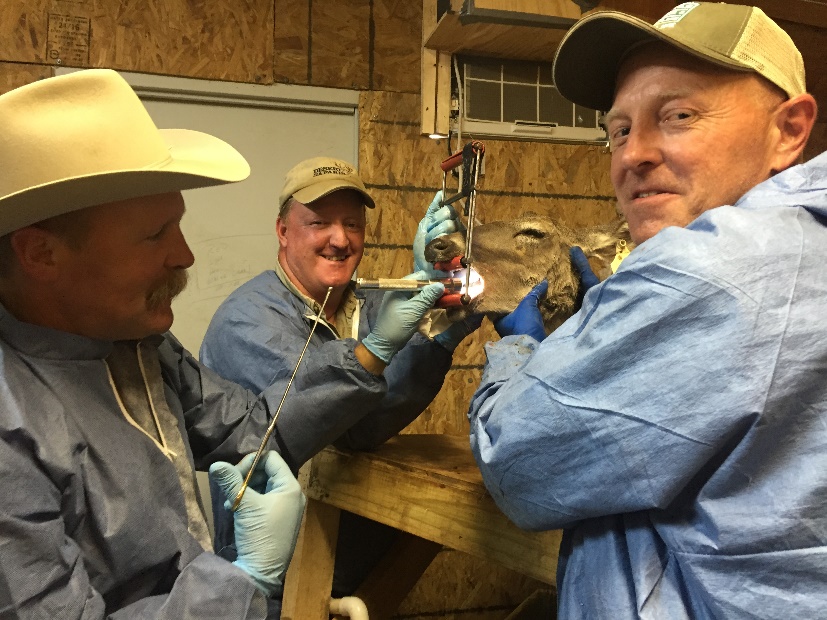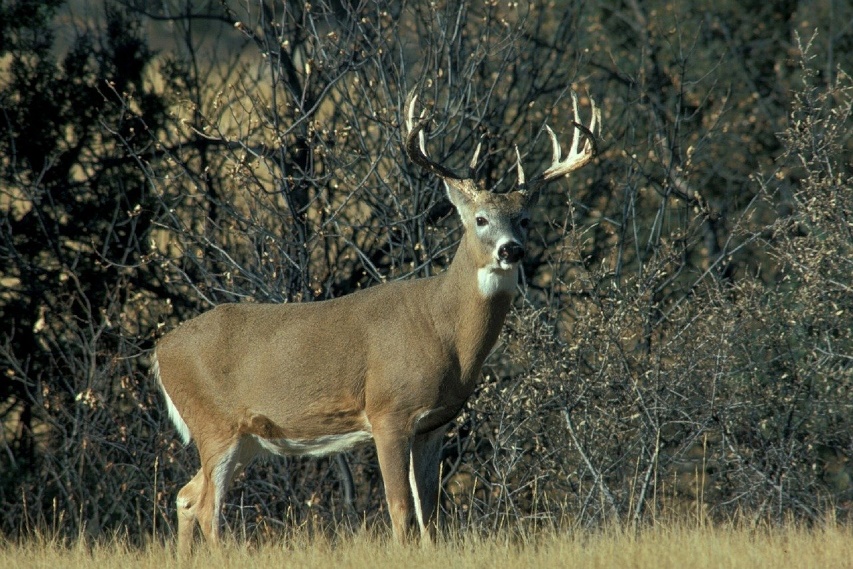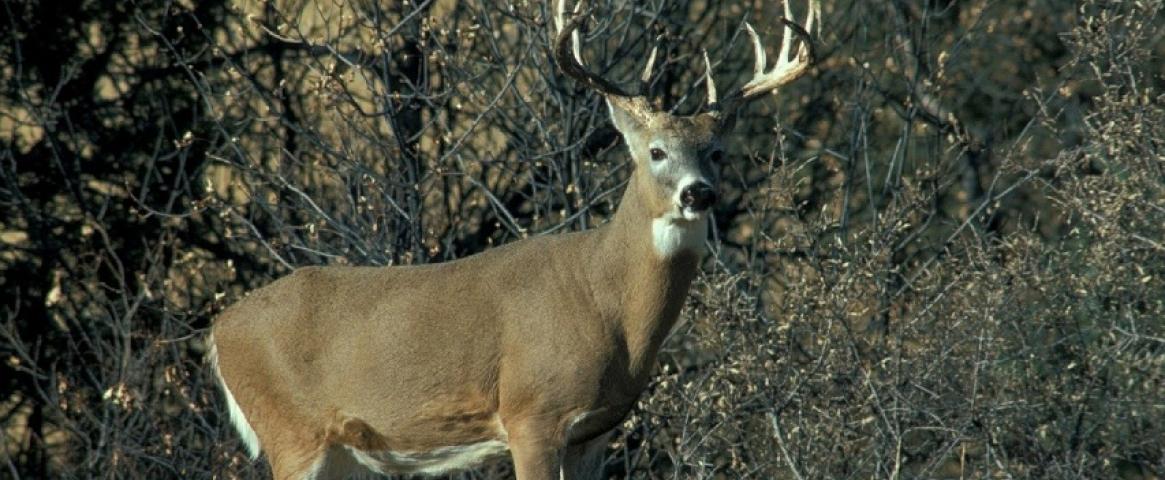By Courtney Adams
A recent study in G3: Genes, Genomes, Genetics, has identified inherited genetic variations associated with chronic wasting disease (CWD) in deer. The authors, who included Texas A&M AgriLife researchers, have developed a custom genomic tool to predict whether white-tailed deer are susceptible to CWD, a finding that could one day help eliminate the deadly disease. This tool will join existing post-mortem and live testing protocols, which protect hunters and could aid in selective breeding of deer.

CWD is a highly contagious disease of deer, elk, and moose that causes abnormal neurological behavior, rapid weight loss, and ultimately death. CWD proteins are shed in bodily fluids before any signs of disease occur, making the spread hard to control. Since the first case was discovered in the late 1960s at a Colorado research facility, CWD has rapidly spread to wild and captive deer in at least 26 states, including Texas.
The two-part study was led by Texas A&M College of Veterinary Medicine and Biomedical Sciences’ Christopher M. Seabury in collaboration with researchers from the Texas A&M Veterinary Medical Diagnostic Laboratory, AgriLife Genomics Core, and Texas Parks and Wildlife Department (TPWD).
Investigating the white-tailed deer genome
In the first part of their study, Texas A&M researchers confirmed that a variation in a gene known to play a role in neurodegenerative disorders (PRNP) does increase a deer’s risk for developing CWD. In addition, they found that other genetic variations also contribute to a deer’s vulnerability to the disease, indicating a need for a whole-genome approach to eradicating the disease.
Mitchell Lockwood, the Big Game Director at TPWD and an author on the study, describes how Seabury’s approach is different than any other. “Most people have been focusing on limited number of locations within the genome,” Lockwood said. “Seabury is looking at the whole genome.”
In the second part of their study, the researchers used genomic predictions to estimate whether deer in their sample had CWD. Their accuracy was 81%. The researchers believe this tool can be the first step in wiping out CWD by using a genomics-based method.
The road to live testing
Before the Texas Animal Health Commission, TPWD, and several individuals worked together to create a live testing protocol, deer could only be tested for CWD in the brain post-mortem in Texas. Macy Ledbetter, a Texas A&M College of Agriculture and Life Sciences former student, joined a team of experts, which included Lockwood, who were determined to change that.
In the late 2000s, Ledbetter, a wildlife biologist who used to work for Texas Parks and Wildlife before starting his own wildlife management consulting business, had been monitoring the surrounding states’ CWD activity and anticipating the disease’s official arrival in Texas.
Eventually, in 2012, the first Texas CWD case was found in a free-range mule deer near the Hueco Mountains, and in 2015, the first positive white-tailed deer was found in Medina county among a captive herd. When Ledbetter and his colleagues began tracing deer from that herd, they found several CWD-positive animals in a nearby herd. Positive CWD cases meant the entire herd had to be culled to prevent the spread, which is what Ledbetter and his colleagues were so determined to change.
“I thought let’s keep them alive and try to move the science ball down the field,” Ledbetter said.
Ledbetter and his team began by taking a sample of live deer from the same pen as the deer that already had tested positive for CWD post-mortem. By taking a biopsy from the pair of lymph nodes behind the jawbone, known as a retropharyngeal lymph nodes, and testing the tissue for CWD, they discovered that all the deer were positive for CWD. Next, they took a biopsy from the tonsils, and discovered that several but not all were positive in this location. A biopsy from the smooth-muscle lining inside the rectum revealed fewer positive results.
Ledbetter’s team hypothesized that the disease probably enters through the mouth and infects the retropharyngeal lymph nodes, travels through the tonsils, and makes its way to the rectum before ever heading for the brain. Therefore, they determined that these less invasive locations could be tested for CWD in live deer.

“We were able to show through data that you can sedate a deer and find CWD without killing the deer, which was incredibly valuable,” Ledbetter said.
By 2016, tonsil and rectal biopsies were widely accepted in Texas for captive populations of white-tailed deer. However, the live testing is not feasible for wild deer. The testing is expensive, and the wild deer are harder to track.
“I hope that Dr. Seabury's [genomic] research can be transferred, translated, and then implemented in the wild deer, “ Ledbetter said. “It gives me positivity moving forward.”
TPWD conducts post-mortem CWD surveillance all over the state in wild populations. “It would be nice if we had a tool available to help us know where to focus our sampling so that we are more effective where we need to be,” Lockwood said.
The findings of this study provide hope that that CWD may one day be removed from deer populations altogether by repopulating disease-ridden areas with animals at a lower genetic risk of contracting the disease.
“CWD genome selective breeding is going to build a better animal, eventually, even at 81% success,” Ledbetter said.
Chronic wasting disease and hunting
In the meantime, CWD continues to spread in deer populations. The white-tailed deer hunting season begins November 7th, and although there is no current evidence that CWD can infect people, hunters should take precautions when harvesting deer. Hunters should be aware of regulations pertaining to CWD, and most importantly, should report any deer displaying odd behavior to TPWD.
When hunting in CWD Containment and Surveillance Zones, hunters are required to have harvested deer tested at a TPWD Check Station within 48 hours. At their May meeting, which was held virtually, the TPWD Commission established new CWD zones in Val Verde County and a new surveillance zone in Kimble County, which expands the existing South-Central Zone that was already in place in Medina, Bandera and Uvalde counties. Unchanged zones include the Trans-Pecos and Panhandle areas.
Courtney Adams is a Science and Technology Journalism graduate student at Texas A&M University. She has written for publications such as CVM Today and Science Editor. Follow her on Twitter @ctayadams or email her at ctayadams@gmail.com.
This story was produced as part of NASW's David Perlman Summer Mentoring Program, which was launched in 2020 by our Education Committee. Adams was mentored by Mark Roth.


